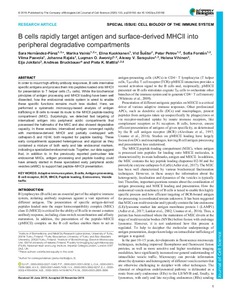B cells rapidly target antigen and surface-derived MHCII into peripheral degradative compartments
Alexey V. Sarapulov; Andreas Bruckbauer; Eija Jokitalo; Elina Kuokkanen; Helena Vihinen; Johanna Rajala; Luqman O. Awoniyi; Marika Vainio; Petar Petrov; Pieta K. Mattila; Sara Hernández-Pérez; Sofia Forstén; Vid Šuštar; Vilma Paavola
https://urn.fi/URN:NBN:fi-fe2021042826543
Tiivistelmä
In order to mount high-affinity antibody responses, B cells internalise specific antigens and process them into peptides loaded onto MHCII for presentation to T helper cells (TH cells). While the biochemical principles of antigen processing and MHCII loading have been well dissected, how the endosomal vesicle system is wired to enable these specific functions remains much less studied. Here, we performed a systematic microscopy-based analysis of antigen trafficking in B cells to reveal its route to the MHCII peptide-loading compartment (MIIC). Surprisingly, we detected fast targeting of internalised antigen into peripheral acidic compartments that possessed the hallmarks of the MIIC and also showed degradative capacity. In these vesicles, internalised antigen converged rapidly with membrane-derived MHCII and partially overlapped with cathepsin-S and H2-M, both required for peptide loading. These early compartments appeared heterogenous and atypical as they contained a mixture of both early and late endosomal markers, indicating a specialized endosomal route. Together, our data suggest that, in addition to in the previously reported perinuclear late endosomal MIICs, antigen processing and peptide loading could have already started in these specialized early peripheral acidic vesicles (eMIIC) to support fast peptide–MHCII presentation.
Kokoelmat
- Rinnakkaistallenteet [19207]
